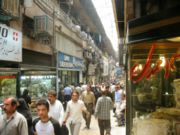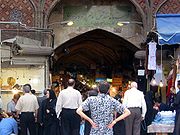
Tehran's Grand Bazaar
Encyclopedia

Iran
Iran , officially the Islamic Republic of Iran , is a country in Southern and Western Asia. The name "Iran" has been in use natively since the Sassanian era and came into use internationally in 1935, before which the country was known to the Western world as Persia...
, Tehran
Tehran
Tehran , sometimes spelled Teheran, is the capital of Iran and Tehran Province. With an estimated population of 8,429,807; it is also Iran's largest urban area and city, one of the largest cities in Western Asia, and is the world's 19th largest city.In the 20th century, Tehran was subject to...
. A bazaar is a type of marketplace, although many - such as Tehran's Grand bazaar - fulfill many additional functions rather than merely trade. Throughout its history, the Grand bazaar has played host to bank
Bank
A bank is a financial institution that serves as a financial intermediary. The term "bank" may refer to one of several related types of entities:...
s and financiers, mosque
Mosque
A mosque is a place of worship for followers of Islam. The word is likely to have entered the English language through French , from Portuguese , from Spanish , and from Berber , ultimately originating in — . The Arabic word masjid literally means a place of prostration...
s and guest houses.
Traditionally, the Tehran bazaar was split into corridors, each specialising in different types of goods, including copper
Copper
Copper is a chemical element with the symbol Cu and atomic number 29. It is a ductile metal with very high thermal and electrical conductivity. Pure copper is soft and malleable; an exposed surface has a reddish-orange tarnish...
, carpets, paper
Paper
Paper is a thin material mainly used for writing upon, printing upon, drawing or for packaging. It is produced by pressing together moist fibers, typically cellulose pulp derived from wood, rags or grasses, and drying them into flexible sheets....
, spices, and precious metals, as well as small traders selling all types of goods. Today, modern goods are available as well, in addition to the many traditional corridor traders that still survive.
The Grand Bazaar is located in southern Tehran; its many corridors are over 10 km in length. There are several entrances, some of which are locked and guarded at night.
History

Trade and early bazaars in Tehran
The area around Tehran has been settled since at least 6000 BC, and while bazaar-like construction in Iran as a whole has been dated as far back as 4000 BC, Tehran's bazaar is not this old. It is hard to say exactly when the "bazaar" first appeared, but in the centuries following the introduction of IslamIslam
Islam . The most common are and . : Arabic pronunciation varies regionally. The first vowel ranges from ~~. The second vowel ranges from ~~~...
, travellers reported the growth of commerce in the area now occupied by the current bazaar. The Grand bazaar is a continuation of this legacy.
Research indicates that a portion of today's bazaar predated the growth of the village of Tehran under the Safavids' dynasty, although it was during and after this period that the bazaar began to grow gradually.
Western travellers indicated that by 1660 CE and beyond, the bazaar area was still largely open, and only partially covered.
Development of the Grand Bazaar
Despite relying heavily on this historical legacy, much of the bazaar itself was constructed fairly recently. The oldest remaining buildings, walls and passages in the bazaar today very rarely exceed 400 years, with many being constructed or rebuilt within the last 200 years. In this sense, the current grand bazaar is one of the newest in the Middle EastMiddle East
The Middle East is a region that encompasses Western Asia and Northern Africa. It is often used as a synonym for Near East, in opposition to Far East...
.
The bazaar grew as a "city within a city" for much of the 19th century, and was largely able to expand itself without much outside interference. However, as Tehran began to grow exponentially in the early 20th century under Reza Shah
Reza Shah
Rezā Shāh, also known as Rezā Shāh Pahlavi and Rezā Shāh Kabir , , was the Shah of the Imperial State of Iran from December 15, 1925, until he was forced to abdicate by the Anglo-Soviet invasion of Iran on September 16, 1941.In 1925, Reza Shah overthrew Ahmad Shah Qajar, the last Shah of the Qajar...
, the changes brought by this rapid expansion saw much of the bazaar (including such areas as the Perfume Sellers' Bazaar and Moat Bazaar) disappear.
The old sections of the bazaar are generally similar in architectural style
Iranian architecture
Iranian architecture or Persian architecture is the architecture of Iran . It has a continuous history from at least 5000 BCE to the present, with characteristic examples distributed over a vast area from Turkey to North India and the borders of China and from the Caucasus to Zanzibar...
, while parts added in the 20th century often look markedly different; critics say that less care was taken in the construction of later sections. However, in an effort to increase the prestige of the bazaar, projects to beautify the bazaar through the use of plaster moulding and decorative brickwork were undertaken late in the 20th century.
The Bazaari and the Islamic Revolution
- See also Iranian revolution - Pre-revolutionary conditions inside Iran
The bazaar is viewed as a force of conservatism in Iranian society, providing strong links between the clergy and the middle class traders. The Iranian Revolution
Iranian Revolution
The Iranian Revolution refers to events involving the overthrow of Iran's monarchy under Shah Mohammad Reza Pahlavi and its replacement with an Islamic republic under Ayatollah Ruhollah Khomeini, the leader of the...
of 1979 received strong backing from these forces. As one of the most important bazaars in the country, the Tehran Grand Bazaar was a centre of pro-revolutionary feeling and finance.
There were several reasons why the bazaar class worked hard to help advance the revolution. The regime of the monarch Mohammed Reza Pahlavi was anathema to the bazaari
Bazaari
Bazaari is the name given to the merchants and workers of bazaars, the traditional marketplaces of Iran. Bazaaris are involved in "petty trade of a traditional, or nearly traditional, kind, centered on the bazaar and its Islamic culture." Bazaari have been described as "the class of people who...
s, who seemed set to lose out as the country industrialised; they feared that they would be left behind and their status in society would be reduced.
Similarly, another concern for the "bazaar class", not just in Tehran but throughout Iran, was that these traditional economic forces did not benefit from the 1974–1978 oil boom, and were thus even more inclined to aid the revolution.
As such, the Grand Bazaar in Tehran was a hotbed of support for the revolution, which positioned itself opposite the pro-Western monarchy. The Grand Bazaar continues largely to support the establishment, particularly as conservative political forces often adopt a low tax, laissez-faire approach to bazaari
Bazaari
Bazaari is the name given to the merchants and workers of bazaars, the traditional marketplaces of Iran. Bazaaris are involved in "petty trade of a traditional, or nearly traditional, kind, centered on the bazaar and its Islamic culture." Bazaari have been described as "the class of people who...
s.
Today

Shemiran
Shemiran is the capital of Shemiranat County, Tehran Province, Iran, but is actually located just north of the borders of Tehran County along Chamran Expressway and Sadr Expressway and it is the northernmost district of the city of Tehran....
, leaving the bazaar somewhat decreased in importance. Still, in addition to the traditional goods on sale, the market for watches and local jewelry is apparently growing, most likely for the benefits of tourists. As is in keeping with the market spirit, tourists are encouraged to haggle. The bazaar sees the peak of its business at midday and between 5 and 7 in the evening.
As of October 2005, plans are in place to construct a hotel in the southern section of the bazaar for the benefit of tourists, in a bid to make the bazaar more hospitable and to regain some of its importance.
See also
- BazaarBazaarA bazaar , Cypriot Greek: pantopoula) is a permanent merchandising area, marketplace, or street of shops where goods and services are exchanged or sold. The term is sometimes also used to refer to the "network of merchants, bankers and craftsmen" who work that area...
- Economy of IranEconomy of IranThe economy of Iran is the eighteenth largest in the world by purchasing power parity and according to Iranian officials' claims is going to become the 12th largest by 2015. The economy of Iran is a mixed and transition economy with a large public sector and some 50% of the economy centrally planned...
- Smuggling in Iran
External links
- Pictures of the Grand Bazaar on BBC
- Grand Bazaar in Tehran
- Tehran's Grand Bazaar Perfume Shop
- Tehran's Grand Bazaar Herb Shop
- Tehran's Grand Bazaar Gold Market
- The Bazzar - "The Iran Primer", United States Institute of PeaceUnited States Institute of PeaceThe United States Institute of Peace was created by Congress as a non-partisan, federal institution that works to prevent or end violent conflict around the world...

